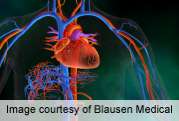Automated ECG directs patients with acute MI to cath lab

(HealthDay)—Use of an automated electrocardiogram (ECG) to diagnose acute ST-segment elevation myocardial infarction (STEMI) activates the protocol for referral to the cardiac catheterization laboratory (CCL) and achieves timely intervention with balloon angioplasty, according to a study published in the July 15 issue of The American Journal of Cardiology.
Brian J. Potter, M.D., of the University of Montreal, and colleagues conducted a study from January 2010 to 2012 evaluating the performance of a novel system that relies on automated ECG alone to diagnose acute MI and immediately activate the CCL.
The researchers found that 136 of 155 activations (88 percent) were appropriate based on detection of ST-segment elevation and diagnosis of acute MI by the automated prehospital ECG. Of these, 128 patients received a final diagnosis of STEMI and eight patients had false-positive results. In almost all patients with STEMI (99 percent), a door-to-balloon time of less than 90 minutes was achieved with a high level of procedural success (94 percent) and low mortality rate (3 percent). Patients who experienced inappropriate activations for CCL had significantly greater rates of hypertension and coronary artery disease and significantly higher presenting heart rates compared with those who had ECG-appropriate activations. In about half of the cases, human error caused inappropriate activation, and machine error occurred in the other half.
"To the best of our knowledge, the present study is the first report of an automated in-the-field STEMI diagnosis and prehospital CCL activation system without paramedic or physician interpretation of the ECG before direct patient access to the CCL," the authors write. "Our results have demonstrated that such a strategy is both feasible and safe and ensured a door-to-balloon time of <90 minutes for virtually all patients."
More information:
Abstract
Full Text (subscription or payment may be required)
Health News
Copyright © 2013

















